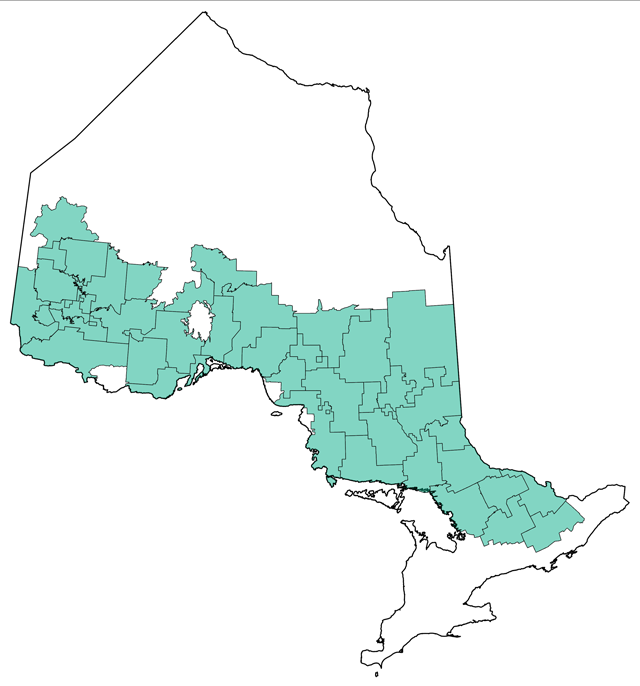Forest management: facts and figures
Read the latest statistics and data for managed public forests.
Ontario’s forests
Ontario has 70.5 million hectares of forest. This represents:
- 66% of Ontario
- 20% of Canada’s forests
- 2% of the world’s forests
Read more about Ontario’s forests in the Forest Resources of Ontario or use this interactive summary of the area of land and water, forest types and tree species across Ontario.
Forest data
Each year, forest managers report on the activities they conduct under approved forest management plans. This information is consolidated into the following facts and figures for Ontario’s managed forest.
Not all statistics are updated to the same year because of the variation in data collection schedules. Each statistic shows when it was updated, in most cases the data is for a fiscal year. For example, 2023 represents April 1, 2023 to March 31, 2024.
Managed forests
Ontario’s public forests are sustainably managed under Ontario’s forest policy framework.
The managed forest is an area in the middle of the province where forest management occurs on public land. It has a large quantity of productive forest that is suitable for timber production.
It spans from Kemptville in the southeast to Pikangikum in the northwest and includes parts of the Boreal Forest and the Great Lakes-St. Lawrence forest, encompassing:
- 46 million hectares of land and water
- 27.8 million hectares of public forest
- 80% productive forests
The managed forest is divided into administrative areas known as management units. They range in size from 300,000 to 3.6 million hectares.
Managed forest and management units 2024
Forest management plans are prepared and approved for each management unit. The plans determine:
- how much can be harvested
- where roads can be built
- how the forest will be regenerated
There are many uses and users of Ontario’s public forests. All forest uses and users are considered when we develop objectives and long-term management direction, and in planning forest operations.
Explore an interactive map of forest management units.
Learn more with this interactive data for the Managed Forest.
Find out how you can get involved in forest management planning and see the planning schedule.
Natural forest disturbances
Natural disturbances occur throughout the life cycle of a forest. A natural forest disturbance is when trees are damaged or killed from:
- forest fire
- insects
- disease
- weather
In 2024 approximately:
- 2 million hectares of forest was affected by natural disturbances (managed forests)
- 31,000 hectares of forest was lost to mortality from natural disturbances
- 1.7 million cubic metres of wood was lost to mortality from natural disturbance including:
- 454,000 cubic metres lost to wildland fires
- 1.1 million cubic metres lost to insects and disease
- 158,000 cubic metres lost to weather events
Find out more with these interactive disturbance charts or download the disturbance data.
Read the annual Forest health conditions report for more on specific forest pests, diseases and severe weather.
Find out more about how we manage forest fires.
Forest harvesting
Through sustainable harvesting, public forests support a forest industry that provides jobs and forest products. About 0.2% of Ontario’s forest is harvested annually.
In 2023 approximately:
- 115,000 hectares of forest was harvested (this represents 41% of the approved area that was available to harvest)
- 12.6 million cubic metres of wood was harvested
- $126.8 million in timber charges (stumpage) for the wood harvested
- 42% of the harvested wood was spruce
- 27% of the harvested wood was jack pine
- 17% of the harvested wood was poplar
- 70% of the harvested wood went to the sawmill and veneer product sector
- 14% of the harvested wood went to the pulp and paper product sector
- 12% of the harvested wood went to the composite product sector
Find out more with these interactive harvest charts or download harvest area data, volume data or stumpage data.
Read more about:
- how we harvest and renew Crown forests
- using trees from Crown forests for commercial purposes
- timber charges
Forest renewal
Harvested forests are renewed (reforested) using tree planting, seeding, or natural regeneration. A forest that was harvested remains a forest. There is no change in land use.
In 2023 approximately:
- 114,000 hectares of forest was renewed
- 60,000 hectares was renewed with natural regeneration
- 54,000 hectares was renewed with assisted regeneration like planting and seeding
- 27,000 hectares of forest was site prepared
- 38,000 hectares of forest was tended
- 162,000 hectares of forest was treated for pests
- 65.2 million trees were planted
- 142 million seeds were dispersed
- $67.2 million was spent on forest renewal activities
Find out more with these interactive renewal charts or download renewal data.
Read more about:
Forest industry
Forest industry operates under the requirements of Ontario’s forest policy framework to conserve the ecological processes and biological diversity of our forests, while providing economic opportunities.
In Ontario the forest industry generates:
- $5.4 billion in gross domestic product (2023)
- $21.6 billion in revenue (2023)
- $8 billion in exports (2024)
- 42,500 direct forest industry jobs (2024)
Find out more with this interactive industry data.
Monitoring and oversight
Oversight is a key component of Ontario’s forest policy framework. We monitor and audit forest management operations to check compliance and evaluate progress.
In 2023 approximately:
- 86,000 hectares of regenerating forest area was surveyed
- 92% of the area surveyed was established (met regeneration standards)
- 2,000 inspections were conducted on forest operations
- 98% of inspections showed operations were in compliance
In 2024:
- 4 independent forest audits were conducted
- 100% of audits showed forests were managed in compliance
- 69% of management units were certified to an international standard
Find out more using these interactive monitoring and compliance charts. Download established area data or compliance data.
Read more about how we:
